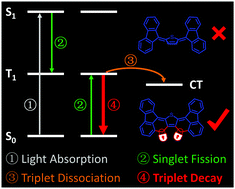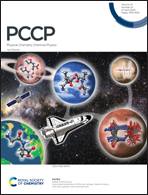Suppressing triplet decay in quinoidal singlet fission materials: the role of molecular planarity and rigidity†
Abstract
Singlet fission, in which one singlet exciton is split into two triplet excitons, provides the potential to exceed the Shockley–Queisser limit for the power conversion efficiencies of organic solar cells. However, the charge transfer from the triplet state is found to be slow in singlet fission materials, so suppression of the triplet decay is crucial for effective utilization of singlet fission. Here, we first investigated triplet decay for the singlet fission molecular materials of ThBF and TThBF, which are characteristic of twisted and flexible quinoidal backbones. It is found that these compounds show rapid nonradiative decay in the Franck–Condon region and through the T1/S0 crossing point. Interestingly, upon locking the backbone twist by methylene, the LThBF and LTThBF compounds exhibit much higher energy barriers from T1 to the T1/S0 crossing point, vanishing spin–orbit couplings, and decreased reorganization energies due to the planar and rigid structures. Consequently, both the triplet decay pathways are effectively suppressed. Our work reveals the importance of molecular planarity and rigidity in suppressing triplet decay and will be very helpful for full utilization of singlet fission in organic photovoltaics.



 Please wait while we load your content...
Please wait while we load your content...